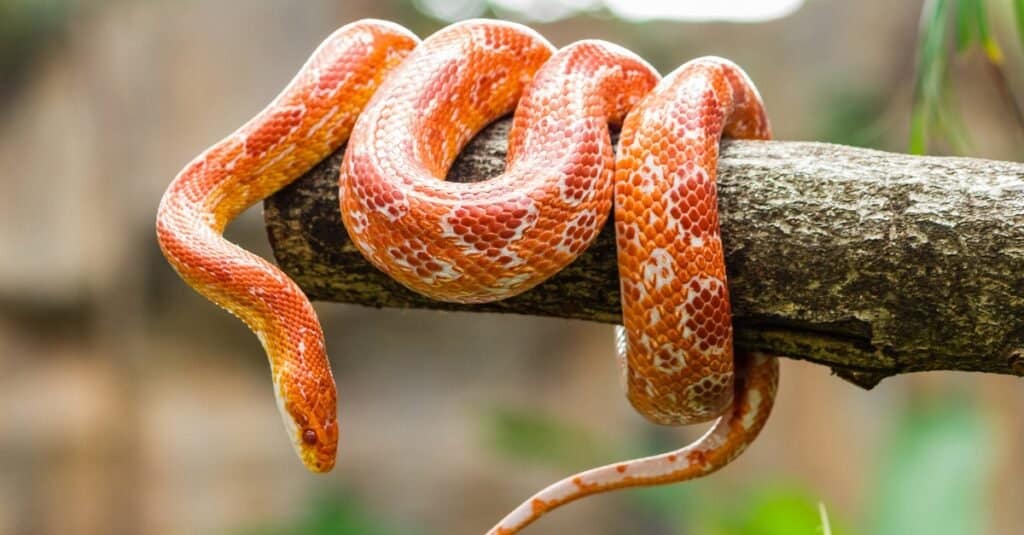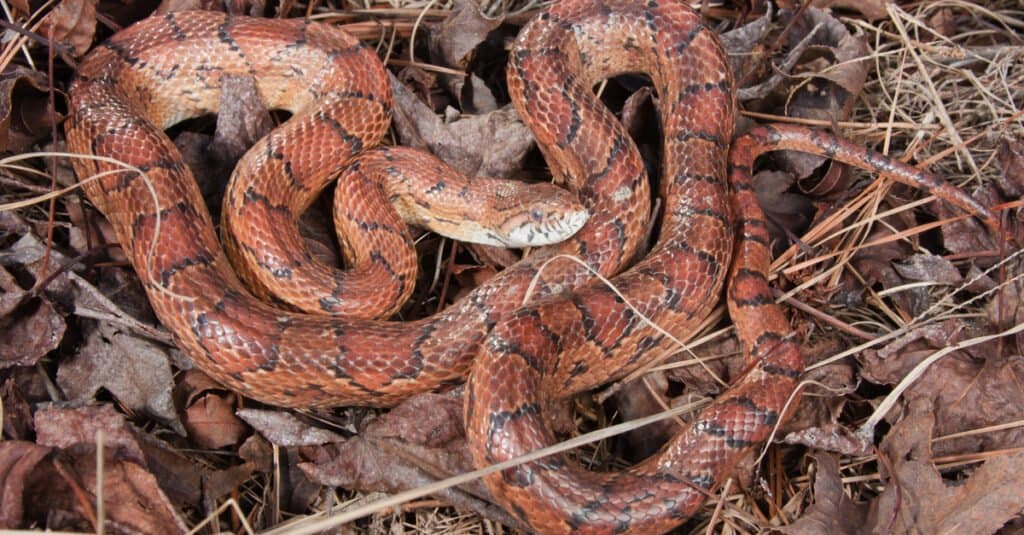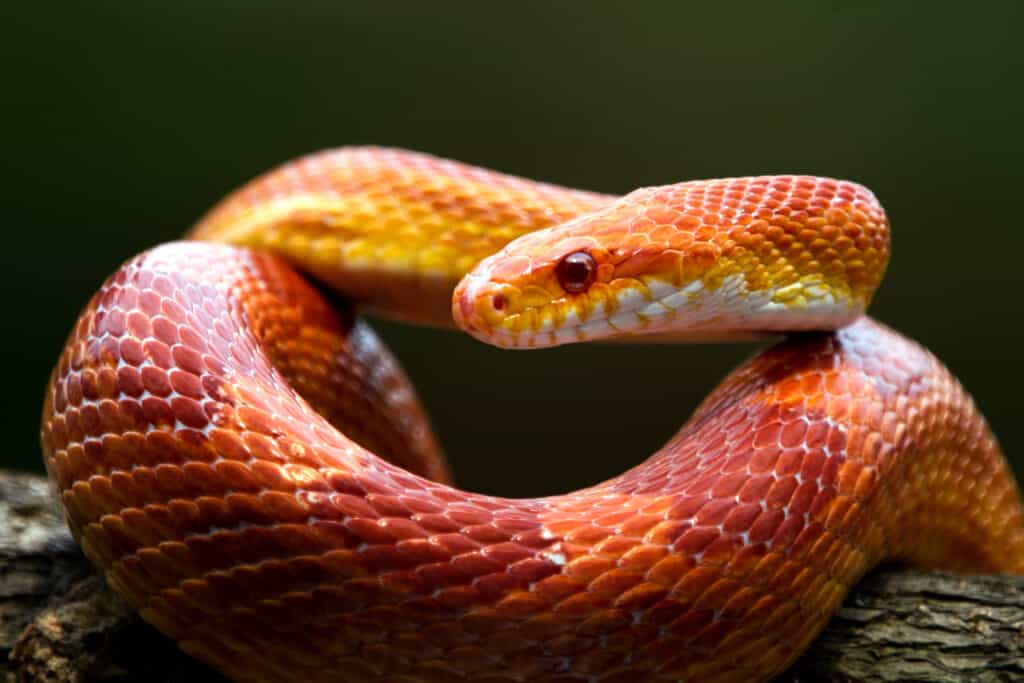Before buying them as pets, people typically want to know if corn snakes are nocturnal or diurnal. But corn snakes exhibit both these sleep patterns, depending on their environments. Because of complex environmental influences, most people believe corn snakes are diurnal. Instead, these reptiles are crepuscular, active at twilight when the sun rises and sets. Additionally, corn snakes have two sleep cycles and are not very active. When they are active, they are hunting or looking for shelter. Here we explore the sleep behavior of corn snakes in the wild and captivity and discuss their unique sleep cycles to improve our understanding of how these reptiles function.
Corn Snakes are Crepuscular and not Nocturnal

Corn snakes are not nocturnal or diurnal but are crepuscular, so they are most active at dawn and dusk when they hunt.
©iStock.com/bugphai
Corn snakes are crepuscular reptiles that are usually dormant during the daytime and nighttime when they sleep. In the wild, corn snakes typically have two sleep cycles. When people keep them as pets, they also have two sleep cycles, but only if they feel comfortable in their enclosure.
Corn snakes become active at dawn and dusk, as this is when they hunt. Their first sleep cycle ends at dawn before they become active. After hunting or finding a hiding spot for the day, the corn snake enters its second sleep cycle until dusk.
If you own a pet corn snake, it is essential to monitor its sleep cycles because these reptiles are not nocturnal or diurnal. If the snake is active throughout the day or night, this is a sign that it is not comfortable in its enclosure. Owners should provide dim lighting and a calm environment to ensure that pet snakes are relaxed and follow natural sleeping patterns.
Where do Corn Snakes Sleep?
Corn snakes sleep and rest in hidden, covered, or protected areas. Some favorite sleeping spots of these reptiles include:
- Logs
- Trees
- Under foliage
- In abandoned buildings
Corn snakes sometimes even sleep under rocks. They choose dark places to nap to avoid direct sunlight during the day and to protect themselves from potential predators. No matter where they sleep, corn snakes use their innate ability (known as crypsis) to select surroundings that provide the perfect camouflage for their markings.
Corn Snake Hunting Behavior

Most corn snakes hunt during the twilight hours.
©Nathan A Shepard/Shutterstock.com
Corn snakes are crepuscular animals and hunt during the twilight. In other words, corn snakes are not nocturnal. Instead, their natural instinct is to hunt at dawn and dusk, often slithering into trees or abandoned buildings for vantage points to hunt and conserve energy. Catching prey in low-light settings is easier when stalking at dawn and dusk.
Despite a preference for hunting in dim light, corn snakes also hunt at night, following other snake species’ cues to find nestlings and eggs. But these snakes prefer being out of sight and commonly track prey in their burrows, like rodents and other small mammals.
Although corn snakes are crepuscular, they become primarily nocturnal during the warmer months. Corn snakes thrive in temperatures between 80 and 85 degrees Fahrenheit. During the warmer summer months, the daily temperatures may exceed this and drive corn snakes undercover throughout the day to wait out the heat. They then come out at night to hunt, becoming nocturnal during the warmer months.
How do Snakes Sleep if they have no Eyelids?
Corn snakes do not have eyelids, which leads many people to wonder how they sleep. Whether nocturnal, diurnal, or something else, corn snakes and all other animals sleep or enter a sleep state as they have to rest their brains. Snakes sleep even though their eyes are “open,” so it is difficult to tell if they are sleeping. However, corn snakes sleep by closing their retina, which means they do not allow light into their eye.
The ability to close their retinas also means snakes cannot see while sleeping even though their eyes are open. One sign that corn snakes are sleeping is to look for their tongue. If they are not flicking their tongues and are still, they are likely sleeping. If your pet corn snake is sleeping and does not move or respond when you lift the lid on its enclosure, it is more than likely in a deep sleep.
Owners Should Monitor the Sleep Behavior of Corn Snakes in Captivity

Owners of corn snakes should try to keep the lights dim during dawn and dusk to mimic their natural habitat.
©Kurit afshen/Shutterstock.com
In the wild, corn snakes have two sleep cycles and are active during the early morning and evening. To ensure that the pet corn snake follows its natural sleep patterns, owners should keep the lighting in and around the enclosure dim and low at dawn and in the evening. This provision will imitate the natural lighting at these hours and stimulate the corn snake’s natural sleep and hunting behaviors.
Corn snakes will come out of their hiding spots during the day when they are comfortable in their environments and with their owners. Owners can also monitor their corn snake’s nocturnal activity if the lights provide enough visibility.
Because of the snake’s sleep cycles, owners should feed them according to their natural routines. Most of their hunting takes place in the wild at dawn, so owners should also feed their pet corn snakes at this time. Sometimes, the corn snake will not eat in the morning because it is tired or its body is cold. If your pet snake is not hungry at dawn, you should start feeding it at dusk when it is warmer and has built up an appetite.
The enclosure’s temperature is also essential to maintain the snake’s natural sleeping behavior. During the day, you should keep the enclosure’s temperature at 80 Fahrenheit and 70 Fahrenheit at night. The corn snake should also have a basking area, which is essential for survival. The basking area should be dim as these snakes do not enjoy bright light. The basking area should be 90 Fahrenheit. Corn snakes need this basking area to regulate their body temperature and sleep behavior.
Nocturnal vs. Diurnal: What’s The Difference?
Navigate to Nocturnal vs. Diurnal: What’s The Difference? for further information about the nocturnal and diurnal phenomenon in various living creatures.
Up Next
- Corn Snake Lifespan: How Long Do Corn Snakes Live?
- 7 Amazing Corn Snake Facts: Get the Scoop Here!
- Albino (Amelanistic) Corn Snake
- Discover the Largest Corn Snake Ever Recorded
The photo featured at the top of this post is © iStock.com/bugphai
Discover the "Monster" Snake 5X Bigger than an Anaconda
Every day A-Z Animals sends out some of the most incredible facts in the world from our free newsletter. Want to discover the 10 most beautiful snakes in the world, a "snake island" where you're never more than 3 feet from danger, or a "monster" snake 5X larger than an anaconda? Then sign up right now and you'll start receiving our daily newsletter absolutely free.
Sources
- University of Georgia, Available here: https://srelherp.uga.edu/snakes/elagut.htm
- Research Gate, Available here: https://www.researchgate.net/publication/308053148_Ecology_and_predation_behavior_of_corn_snakes_Pantherophis_guttatus_on_avian_nests
- Research Gate, Available here: https://www.researchgate.net/publication/338965759_Corn_Snakes_Can_Behaviorally_Enhance_Crypsis_by_Choosing_Complex_Backgrounds_and_Substrate
Thank you for reading! Have some feedback for us? Contact the AZ Animals editorial team.






